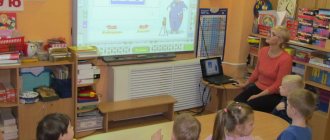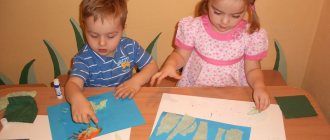Federal State Educational Standard for Educational Education "Thematic days in the educational process."
Many articles from work experience have been written about how interesting it is to organize the lives of children in kindergarten. Teachers develop scenarios for classes, holidays and entertainment, materials for project activities and much more. All this is just as important as designing a holistic model for organizing the educational process for the entire academic year, including these individual events. In other words, create a system and consistency in planning the educational process.
Pedagogical tasks in all educational areas of FG'OS DO are implemented in the educational process of kindergarten. Each institution independently designs a model for organizing the education and upbringing of preschool children and draws up its own basic educational program.
The principle of comprehensive thematic planning, taking into account the integration of educational areas, involves the inclusion of thematic weeks, thematic days, and thematic walks.
Let's try to understand these concepts. All original variable educational programs for each age group present topics for the entire school year, which are usually used by educators.
The selection of topics makes the educational process systematic and is aimed at expanding the child’s awareness of the world around him.
A creative approach to modeling the educational process assumes that the teacher independently (at his own discretion) can partially or completely replace the topic, adjust the content of the work, and include a regional and cultural component, taking into account the characteristics of his preschool educational institution.
If you look into history, the thematic principle of organizing the educational process in working with preschoolers was proposed by many specialists.
Belgian educational psychologist, doctor J.O. Decroli (1871-— 1932)
in his work “The School of Life for Life” he wrote: “My goal is to create a connection between the sciences and make them converge in one center. This center is the child to whom everything converges and from which everything diverges.” He created the “School of Life through Life” for children, where “interest centers” were developed for preschoolers, the essence of which was to organize children’s work around topics that meet children’s interests and needs. In these centers, children observed, read, wrote, drew, and sculpted things that were related to the topic given to them.
In modern practice, speech therapists actively use the thematic principle of planning and organizing work with preschoolers, selecting a variety of material on topics. E. Alyabyeva’s book “Thematic days and weeks in kindergarten” by the publishing house “TC Sfera” has long been in high demand among educators.
Answering the question “What is a theme day in kindergarten?”, we can say that for children it is an unusual day. It is filled with surprises, games, riddles, and exciting journeys. On this day, children learn a lot of new, useful and interesting things, they are sure to make something, draw, and fantasize. On this day, something changes in the group room: new toys appear, favorite cartoon and fairy tale characters come to visit, and sometimes a puppet theater comes.
For the teacher, the theme day is pedagogical creativity, ingenuity and transformation. This is serious planning of all routine moments, a departure from the traditional outline plan to drawing up a scenario for the day as a whole or its components - routine moments. To make this day memorable for children, the teacher comes up with surprise moments, elements of involving children in games and exciting activities.
In an ordinary, traditional day, the basis is the routine, and the content is, as it were, strung together with routine moments. Often, a morning reception, gymnastics, or a walk in their content may not be completely combined with the content of the educational activity itself and exist on their own.
The difference between a themed day and a traditional one is that at the center of the pedagogical process is a theme chosen by the teacher for educational purposes and combined with a holiday or calendar event. The theme of the day sets the content, which is implemented in various types of children's activities (play, communication, cognitive-research, perception of fiction and folklore, self-service and basic household work, construction, visual, musical and motor).
A game (role-playing, directorial, dramatization, with rules, etc.) is also one of the forms of content implementation. Considering the game as a free independent activity for children, the teacher thinks through how most of the content of the thematic day can be implemented. Thus, in older groups, travel games appear, for example, in time. And then the interested participation of children according to the principle “let’s come up with some more…” saturates the educational process with the interests of children, and not just adults. They become not performers, but active participants in the simulation of such a game.
When organizing a theme day, the content of the educational areas is naturally integrated. This allows the teacher to integrate educational activities and avoid unjustified fragmentation of children's activities into educational areas. During such days, the teacher shows his creativity, takes into account the characteristics, level of knowledge and skills of the children in his group.
A theme day is about immersing children in a topic, which gives them the opportunity to realize and feel what the teacher wants to convey to them.
The theme of the day can be the same for all age groups or chosen only for a specific age. For example, on the first day of summer (June 1), World Milk Day is celebrated (as proposed by the UN Food and Agriculture Organization since 2001). The purpose of the holiday is to popularize milk and dairy products, inform the population about activities related to dairy production.
On this day, the preschool educational institution can organize fun milk-themed performances with fairy-tale characters, games and sports competitions. Stories about the benefits of milk, dishes that can be prepared using it, and treating children to milk will make this themed day not only fun, but also delicious. A thematic day can be organized for all groups at the same time, but each teacher selects his own content and forms of organizations, focusing on common events (entertainment, performance, competition, etc.).
A single theme in different age groups ensures the achievement of unity of educational goals and continuity in development from age to age.
When drawing up a scenario for a thematic day, it is important for the teacher to observe several important conditions:
- be able to objectively assess the level of one’s work, the actual situation and conditions in which educational activities are carried out at the time of planning (what the children and I have already gone through, what results have been obtained);
- be able to identify goals and objectives, correlating them with the educational program, age composition of a group of children, priority areas of the entire educational process in preschool educational institutions;
- clearly represent the results of the work that must be achieved (what new children will learn, what they will learn, what personality traits they will develop);
- choose the optimal forms, means, methods that help achieve your goals, and therefore obtain the planned result.
The plan-scenario of the thematic day should ensure the unity of the educational, developmental and training goals and objectives of the education of preschool children and the integration of educational areas.
I would like to remind you that the principle of integration of educational areas underlies all the work of the educator, and, in our opinion, it is not at all necessary, after planned work, to constantly indicate in brackets which educational areas this or that activity belongs to.
With the introduction of the Federal State Educational Standard for Preschool Education and following the logic, it can be argued that if the educational process in kindergarten unfolds in a complex thematic model and educational tasks are implemented not only in the classroom, but also in routine moments according to the developed daily scenario in each group and throughout the kindergarten .
In our kindergarten, theme days are included in the educational program. And this was done quite creatively, without driving the teacher into another “trap” - obligatory! A collection of interesting themed day scenarios is created through the creative efforts of the entire teaching staff. Each scenario is actively discussed both before and after the theme day, and only the successful ones are kept in the kindergarten teaching room. This work experience may be useful to other educators in the future. This makes the model of our educational process diverse and is reflected in the educational program of the kindergarten.
In comprehensive thematic planning, the requirements for the conditions for the implementation of the preschool education program are observed, one of which is “the use in educational activities of forms and methods of working with children that correspond to their age and individual characteristics (the inadmissibility of both artificial acceleration and artificial slowdown of children’s development)” ( Federal State Educational Standard DO).
Our teaching staff independently decides how often themed weeks, themed days, and themed walks will be planned. We are sure that there cannot be strict regulation here.
The principle of complex thematic planning and its inclusion in the model of organizing the educational process is being developed and widely discussed at teacher councils.
Methodological development of a thematic day at a preschool educational institution “Camp Day”
"Camp Day"
1. Goals and objectives.
Target:
creating conditions for children to have a good rest.
Tasks:
introduce children to the most interesting traditions and customs of the camp and the leader’s detachment;
develop children's creative potential;
open the mind;
give children the opportunity to try themselves in the work of a leader;
increase the authority of the counselor;
bring children together;
2. Equipment.
Line: camp flag, anthem soundtrack, route sheets, balloons, material for a fire.
Stations: map with places of work of the detachment, crossword puzzles on the history of the detachment, detachment albums, flag and symbol of the camp, audio cassette, cards with pedagogical situations, drawings, stage costumes, makeup, fabric, paints.
3. Progress of the event.
Line: after breakfast, all teams, including the squad of counselors, gather for a line. The squad leaders submit a report to the head of the camp program, and the senior counselor submits a report from the squad of counselors. The line says about the purpose of the collection: from the beginning of the season, the leader of each group tells the children that the constellation of the eagle appears in the sky only in the summer. Emergence Day is the only day of the year when all children can become counselors. To do this, children need to collect a constellation (stars for the constellation are given after successfully passing each station), show the “leader” numbers, sing a song and undergo an initiation ceremony.
A ceremonial raising of the flag is held to the soundtrack of the camp anthem. The units are given route sheets indicating the location of the stars. After finishing the line, the squads disperse to stations.
Stations: (conducted by counselors, the number of stations is equal to the number of stars in the constellation Eagle) 1. History (one squad comes running to the station).
The history of the camp is told. Children get acquainted with the customs and traditions of the camp, then children are offered crossword puzzles based on the material they listened to.
2. Dancing.
At this station, the entire squad lines up in a checkerboard pattern, and learns to dance a traditional camp dance to the soundtrack.
3. Costume room.
The squad is offered costumes, wigs, and makeup to create images of some characters (determined by the counselor conducting the station). Similarity to the characters, children's enthusiasm and creative presentation are assessed.
4. Shouts.
Children are shown drawings with which they must remember the chants. Then the squad is offered a set of words, using which they need to compose chants about the counselors and the camp.
5. Song.
At the station, the children learn the camp song, which will be performed in the “Eagles Circle” at the evening bonfire.
6. Pedagogical situations.
At the station, children act as counselors; they are given the opportunity to independently find a way out of a difficult situation.





